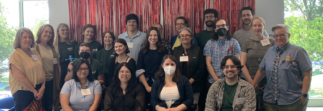
Photo by: L. Barry Hetherington
“In the applications of technological process to intellectual expansion, there lies a natural field of leadership for MIT. Accordingly, the Hayden Library will provide a laboratory in which these and other processes can be explored.” — The Charles Hayden Memorial Library, 1946 (page 13)
These words, written at the dawn of the post-war era, outlined MIT’s ambitious plans for its new central library, the Charles Hayden Memorial Library. Designed to serve as an “integrating force” at the Institute, the Hayden Library launched the expansion and modernization of MIT’s academic facilities. After opening in 1951, Hayden served this role well for many years, adapting to technological and programmatic changes, and hosting generations of MIT students. Now over sixty years old, Hayden Library requires significant investment to renew the building’s infrastructure, and to provide the flexibility needed to meet the needs of current and future students, faculty, and researchers. The redesign of Hayden also provides an opportunity to rethink library spaces across campus.
The Libraries began exploring library space upgrades in the fall of 2011, and engaged the architecture firm Shepley Bulfinch to develop a framework for space planning over the next five to ten years. Completed in June 2012, the Phase One report envisions library spaces in Hayden (Building 14) as the hub of the library system, providing a rich mix of learning environments and collections for science, engineering, humanities, music, and archives. It endorses the concept of Hayden becoming a library-centric academic village. To complement the remodel of Hayden, the report suggests that Barker Library, in the dome of Building 10, should expand its 24-hour study spaces, offering a mix of quiet study, collaborative, and instructional space, but largely without tangible collections or a traditional staffed service point. Two specialized facilities, meeting the needs of their campus neighborhoods, would remain: Rotch Library in Building 7, serving architecture, art, and planning; and Dewey Library in E53, serving management, economics, and political science. Such a strategic shift would strengthen the Libraries, ability to support and enhance the academic priorities of the Institute.

Hayden Library in the 1950s
Additionally, MIT’s Capital Renewal Program documented numerous capital renewal needs to be addressed in library spaces including accessibility, safety, and infrastructure issues (elevators, mezzanines, restrooms, and HVAC). Based on these reports, MIT approved the launch of Phase Two of library space planning last fall and selected the firms Shepley Bulfinch, and Van der Weil Engineering to create conceptual and schematic designs for a series of phased renovations that will respond to both program and capital renewal needs within Hayden Library. The project will also create conceptual designs for targeted renovations to Barker Library’s 5th floor perimeter and upper floors (building on the successful renovation and restoration of the 24x7 reading room), and improvements to Rotch Library.
Feedback and support from the MIT community are essential to any library space changes. Meetings have been held with faculty, students, and staff to solicit program ideas for library spaces with a particular focus on Hayden Library. Programming for Phase Two will be informed by the Libraries’ strategic plan, MIT’s Capital Renewal processes, and 2030 campus planning effort, as well as Capital Campaign fundraising efforts, and new Innovation and Future of Education initiatives. The feasibility and impact of early concepts and ideas will be shared with the community and library staff in a recently launched webpage. The Libraries look forward to what promises to be an exciting new era of space renewal — redesigning library spaces into a modernized version of the “laboratory” envisioned for Hayden decades ago— a vibrant place for study, learning, experimentation, and collaboration.
Excerpted from an article in the September/October issue of the MIT Faculty Newsletter.


